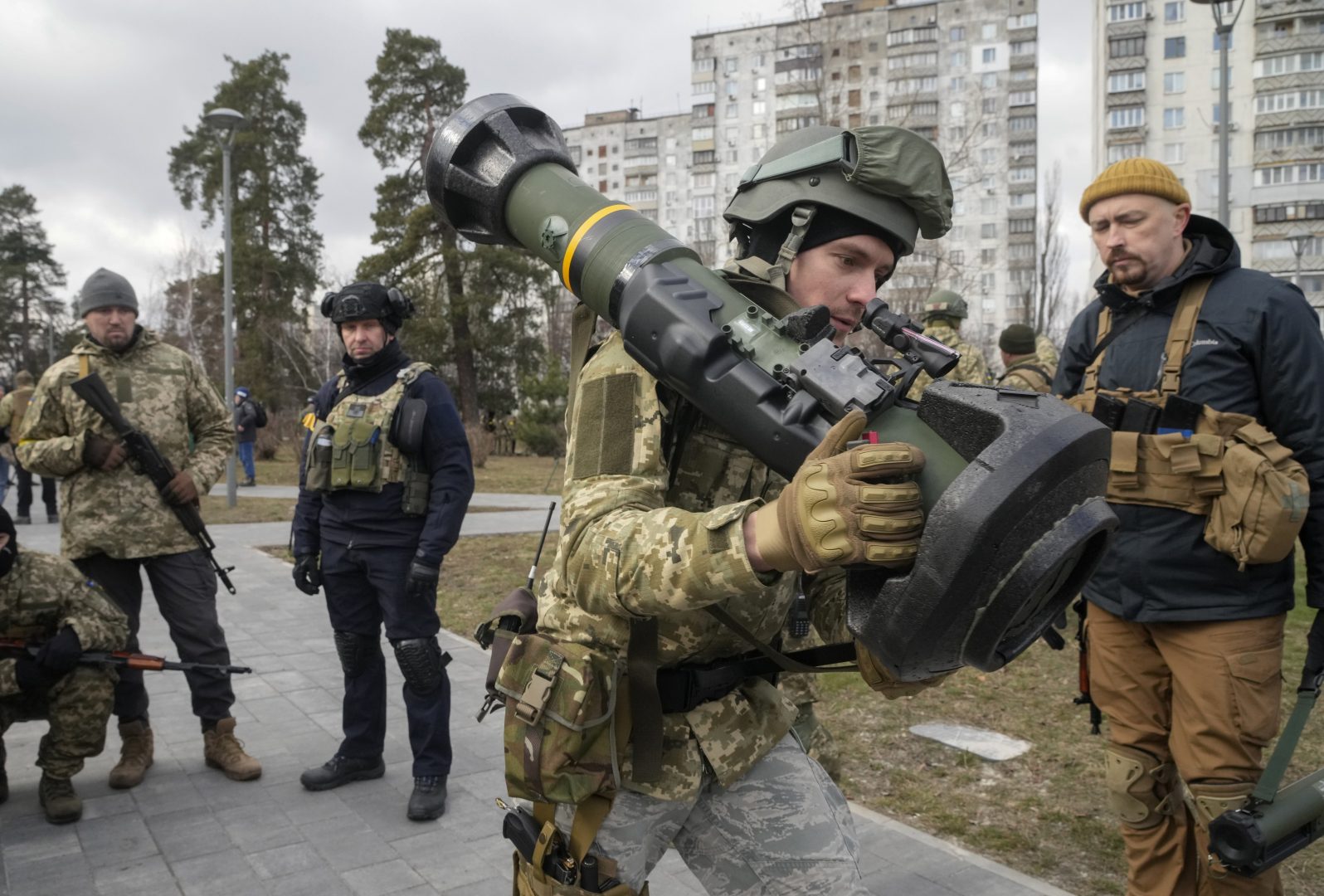
FILE - A Ukrainian Territorial Defence Forces member holds an NLAW anti-tank weapon, in the outskirts of Kyiv, Ukraine, March 9, 2022. (AP Photo/Efrem Lukatsky, File)
Efrem Lukatsky / AP

FILE - A Ukrainian Territorial Defence Forces member holds an NLAW anti-tank weapon, in the outskirts of Kyiv, Ukraine, March 9, 2022. (AP Photo/Efrem Lukatsky, File)
Efrem Lukatsky / AP

Efrem Lukatsky / AP
FILE - A Ukrainian Territorial Defence Forces member holds an NLAW anti-tank weapon, in the outskirts of Kyiv, Ukraine, March 9, 2022. (AP Photo/Efrem Lukatsky, File)
Russia has a huge firepower advantage in its war on Ukraine. In keeping with its military tradition, Russia is relying on heavy weapons such as tanks, artillery guns and fighter jets.
Yet the Ukrainians have far exceeded expectations on the battlefield by making the most of smaller, but more mobile weapons systems, including a number of key ones provided by the United States.
Here are some commonly asked questions regarding Ukraine’s weapons:
Q. What has been the most important weapon in Ukraine’s arsenal?
Javelin missiles. Outside military circles, these weapons first received widespread attention in 2019 when then-President Donald Trump held his infamous phone call with Ukraine’s new elected president, Volodymyr Zelenskyy.
Zelenskyy pleaded for more Javelins, which the U.S. was already supplying, to defend against the pro-Russia military forces already in the east of Ukraine.
The Trump administration was delaying the delivery of military assistance, and the U.S. president asked for a political favor — an investigation of the Bidens.
That call set off a chain of events that led to Trump’s first impeachment. Zelenskky got the additional Javelins, which have made a huge difference in the fighting.
Q. How are the Ukrainians using the Javelins on the battlefield?
The Javelins are largely responsible for the daily scenes of burned out Russian tanks and other armored vehicles strewn along the roads of Ukraine.
The weapons are simple and deadly. A soldier puts it on his shoulder, then points and shoots.
To date, Russian armored columns have been unable or unwilling to push into Ukrainian cities, and the Javelin missiles appear to be a key reason.
President Biden on Wednesday authorized an $800 million package of military assistance for Ukraine. They include 9,000 anti-armor weapons, many of them believed to be Javelins.
Q. That’s on the ground. We’re hearing a lot about Russia’s advantage in air power. How are the Ukrainians countering that?
Stinger missiles. These work on the same basic principal as the Javelins, but are for aircraft.
They are portable, shoulder-fired missiles that have brought down low-flying Russian planes and helicopters. Most accounts say the Russians have lost more than two dozen aircraft, though reliable figures are hard to come by.
Russian pilots are well aware of how deadly the Stingers can be. The U.S. gave them to Afghan rebels during the Soviet war there in the 1980s.
The Soviets relied heavily on helicopters in Afghanistan, and the Stingers made it much more dangerous for the Soviets to use them. Many military analysts say the Stingers changed the tide of the war, which ended with the Soviet withdrawal in 1989.
The Biden administration’s aid package includes 800 anti-aircraft weapons, many believed to be Stingers.
Q. Still, Ukraine doesn’t have much air power of its own, right?
True. According to the U.S., Russian pilots are flying an average of 200 missions a day in fighter jets, compared to 10 or fewer for the Ukrainians.
But Ukraine does have drones it got from Turkey, and they have been effective, according to military analysts.
The new U.S. package will include 100 drones, reportedly a model known as Switchblades. One model is small enough for a solider to carrying in a backpack, weighing just five or six pounds and requiring minimal training.
They are often referred to as “Kamikaze drones” because they don’t actually fire their weapon, which is similar to a hand grenade. Instead, a soldier remotely guides the drone into the target and it explodes.
Q. The fighting is now in its fourth week, and has already been devastating. What should we expect in the coming days?
Expect battles for the capital Kyiv and other big cities. The Russian forces are stalled on the outskirts. They are using their heavy weapons — tanks, artillery guns and fighter jets — to shell the cities, hoping to pound the Ukrainians into submission.
The Ukrainians can’t stop this bombardment. But they have been able to use their highly mobile, portable weapons to keep the Russians out of the urban areas. The Ukrainians still hold all the major cities.

Get insights into WITF’s newsroom and an invitation to join in the pursuit of trustworthy journalism.
The days of journalism’s one-way street of simply producing stories for the public have long been over. Now, it’s time to find better ways to interact with you and ensure we meet your high standards of what a credible media organization should be.